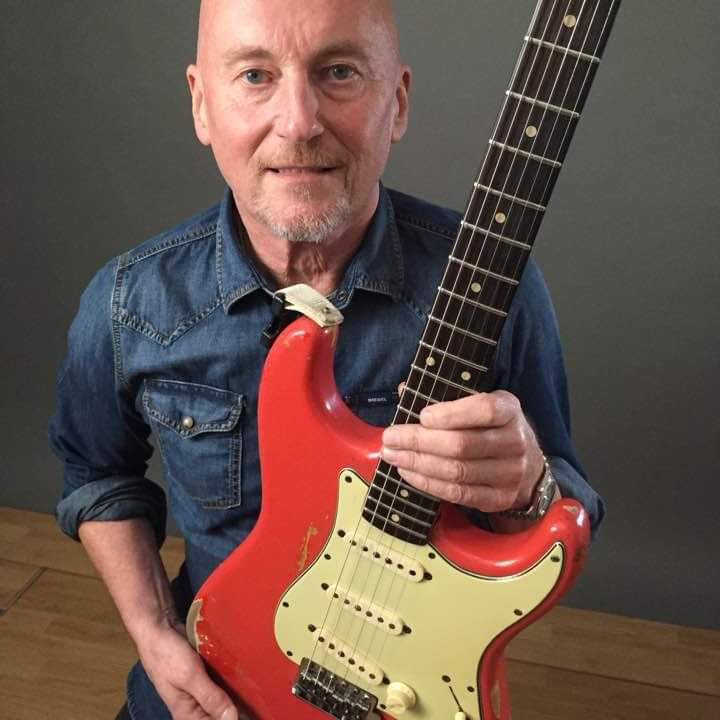Tony Iommi: "I’ve always had determination. I had to go against all the people who said, 'You’re never going to be able to play guitar'"
The Black Sabbath guitarist and architect of heavy metal on a lifetime in riffs, bandmates and his trusty Monkey SG
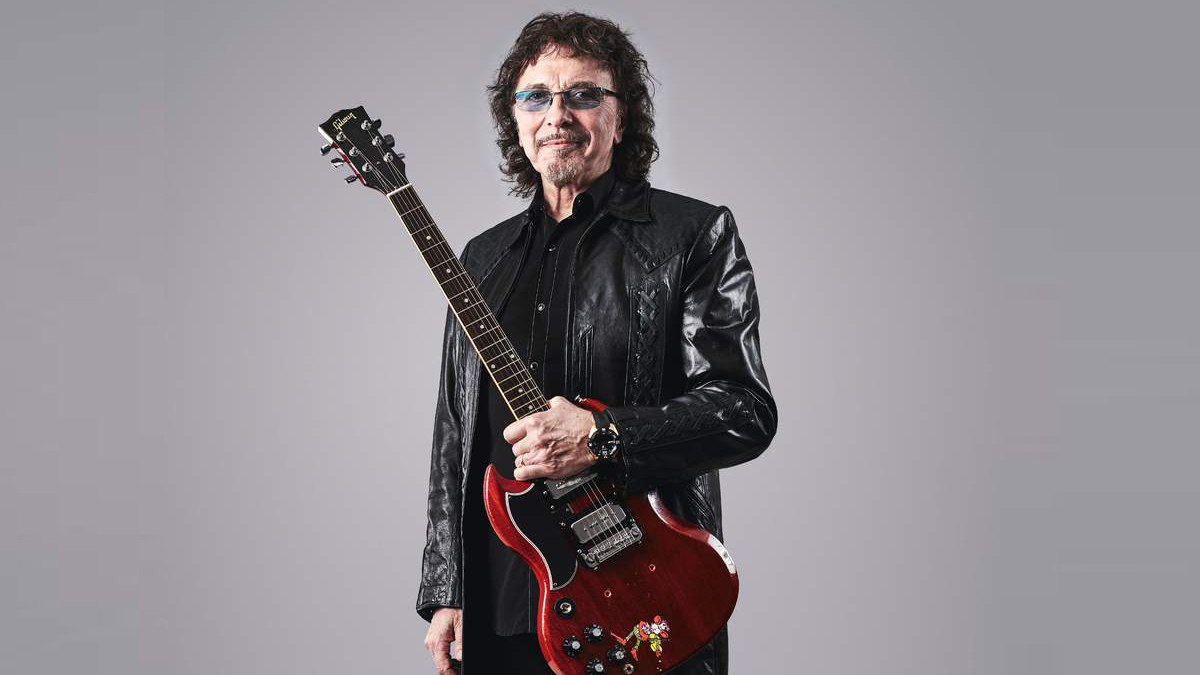
Tony Iommi truly is the iron man of rock. After a hand injury that would have halted most guitarists in their tracks, he battled a constant “you can’t do that” from parents, record companies and guitar builders, survived a revolving door of bandmates (since 1968 he’s been Black Sabbath’s only constant member), and even beat cancer.
To honour his astounding career, Gibson has recreated his heavily modified SG Special, the ‘Monkey’ guitar. Here, Tony weaves the tale of this instrument into the story of a career that, without such dogged determination, might never have happened…
First of all, tell us about the monkey sticker. Does it have a particular significance?
“Well, I had this jacket that I bought from Take 6 in London. I just barely afforded it and I wore it all the time. I wanted to make it a bit different for on stage, so I started putting metal stars and things on it. Then I found these monkeys and I thought, ‘I’ll put a couple of them on, and I’ll put one on the guitar as well.’ So I put one on the guitar and it became known as the ‘Monkey’ guitar.”
And how did the idea come about to recreate the Monkey SG with Gibson?
“It’s been talked about for quite a while. When the new owners came in they said, ‘Let’s do it’ – because that is my original guitar that was on all the early albums. I had a right-handed SG, upside-down, which I strung left-handed. But I heard of this guy who’d got a left-handed SG; he was right-handed and he played his upside-down. I didn’t know him from Adam, but we arranged to meet in a carpark. It looked a bit dodgy, but I finally got a left-handed SG."
“I had a Strat, which I played mainly, and I wanted another guitar as a spare. But when we came to record the first album [Black Sabbath], I played the very first song, Wicked World, with the Strat, and the pickup went, which is weird. In those days you couldn’t just go to the shop and get a pickup, and we only had two days in the studio. So I thought, ‘I’ve got to use this SG,’ and I ended up playing several albums on it.
All the latest guitar news, interviews, lessons, reviews, deals and more, direct to your inbox!
“The band’s sound developed over a period. We’d be getting louder and heavier, and we decided this was the way we wanted to go – and I came up with that Wicked World riff. It was the first song we ever wrote and we really liked the way it was going. Black Sabbath was the next one. We played these in a blues club and people in the crowd came up afterwards: ‘What was that? We really liked it.’ ‘Oh, that’s one of our own songs.’ That sparked it all off, really. Black Sabbath was the benchmark of where we were going to go, and off we went.
Geezer came in in this long hippie dress. I’ve got my leather jacket on. Ozzy came with a shirt and a tap round his neck. I thought, ‘Bloody hell!’ We were a right odd bunch
“I think where we come from was also a great influence on the music, because it was a bit dismal where we lived. There were always gang fights and God knows what else. We worked in factories. I did and Ozzy did. Geezer was in the office; he was going to be an accountant. But there was a desire to escape, without a doubt. I’d always have these dreams of being on stage.
"But I never thought it would be musical, because I used to do contact sports. I thought it would be doing something like that. It was so weird when music took over. I remember playing one night and thinking, ‘Blimey, this is that image I used to see, of being on stage.’”
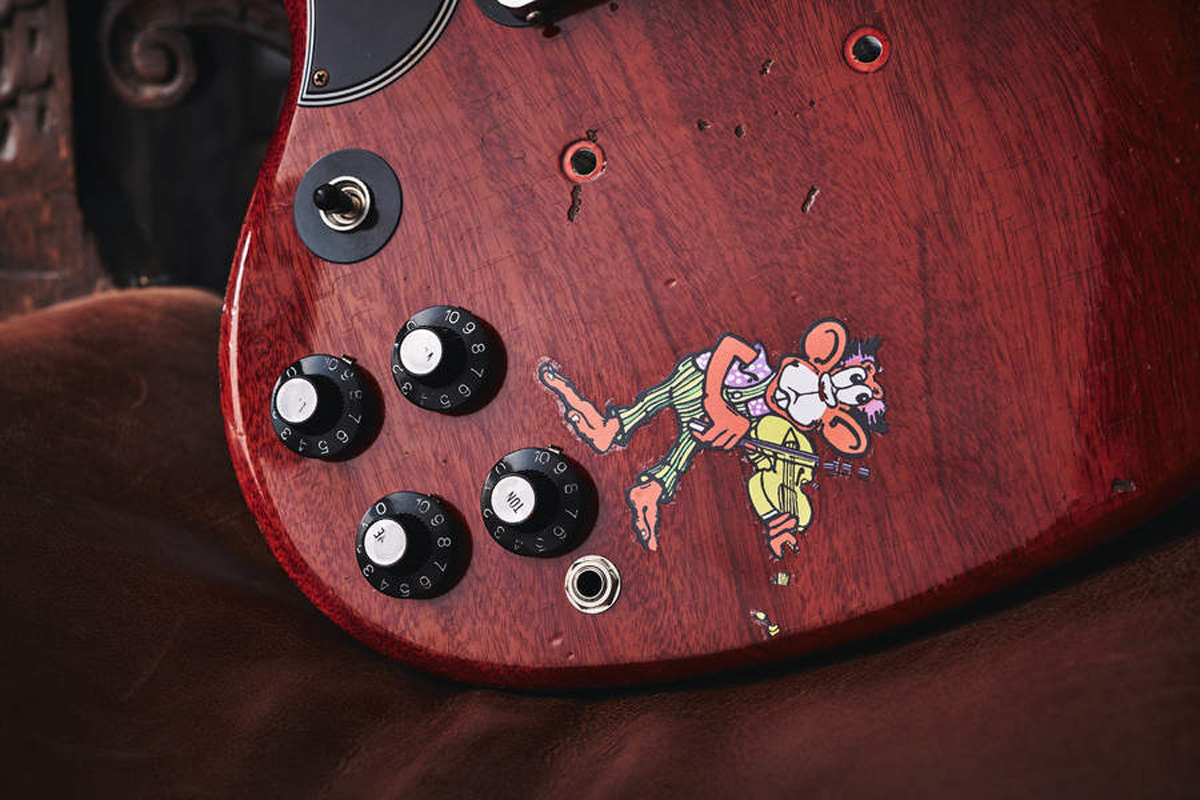
"Even the monkey sticker, where the transfer’s gone a bit; they’ve copied that”
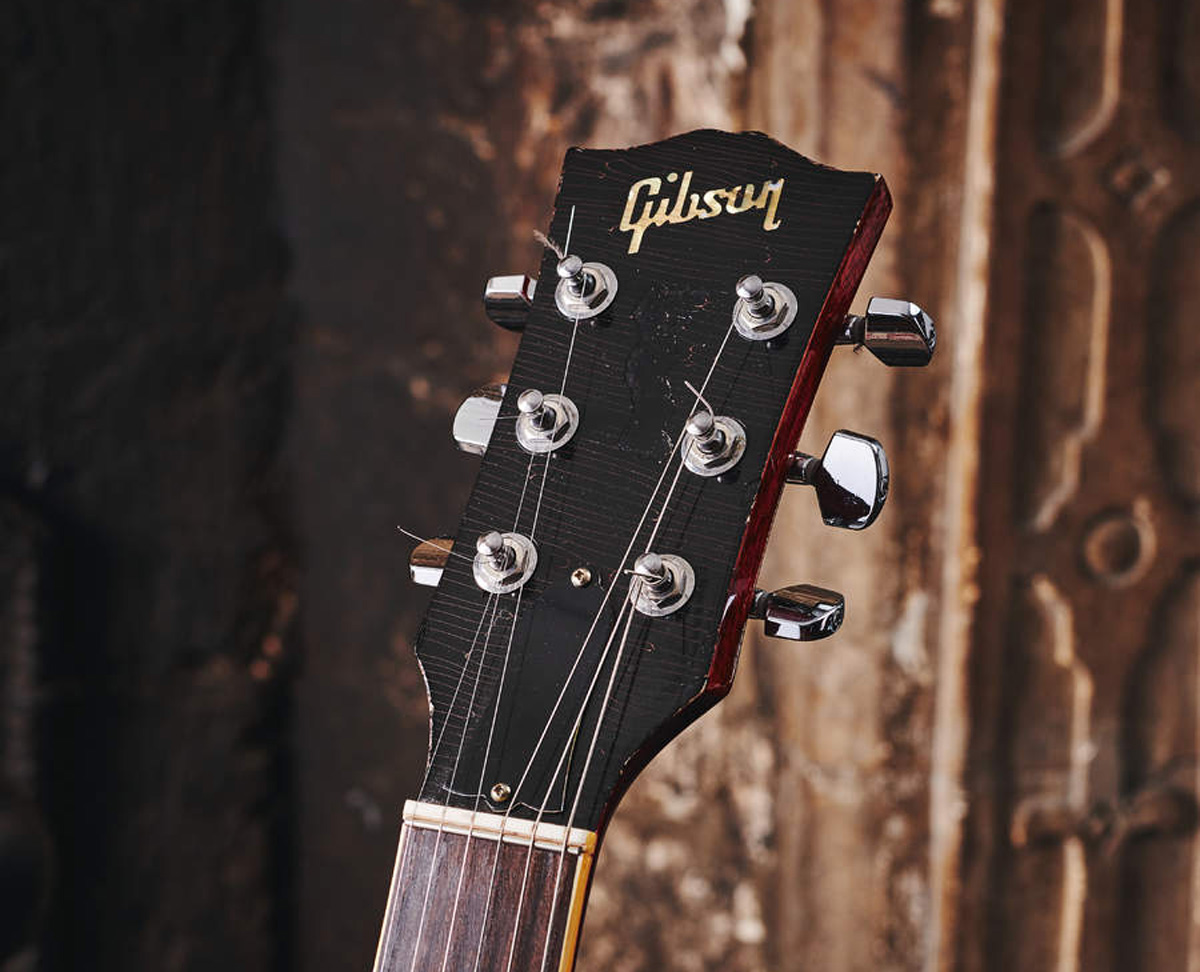
“I also had a first fret put on, just to help with the tuning. With the light gauge strings that I was using, it was always difficult to tune it”
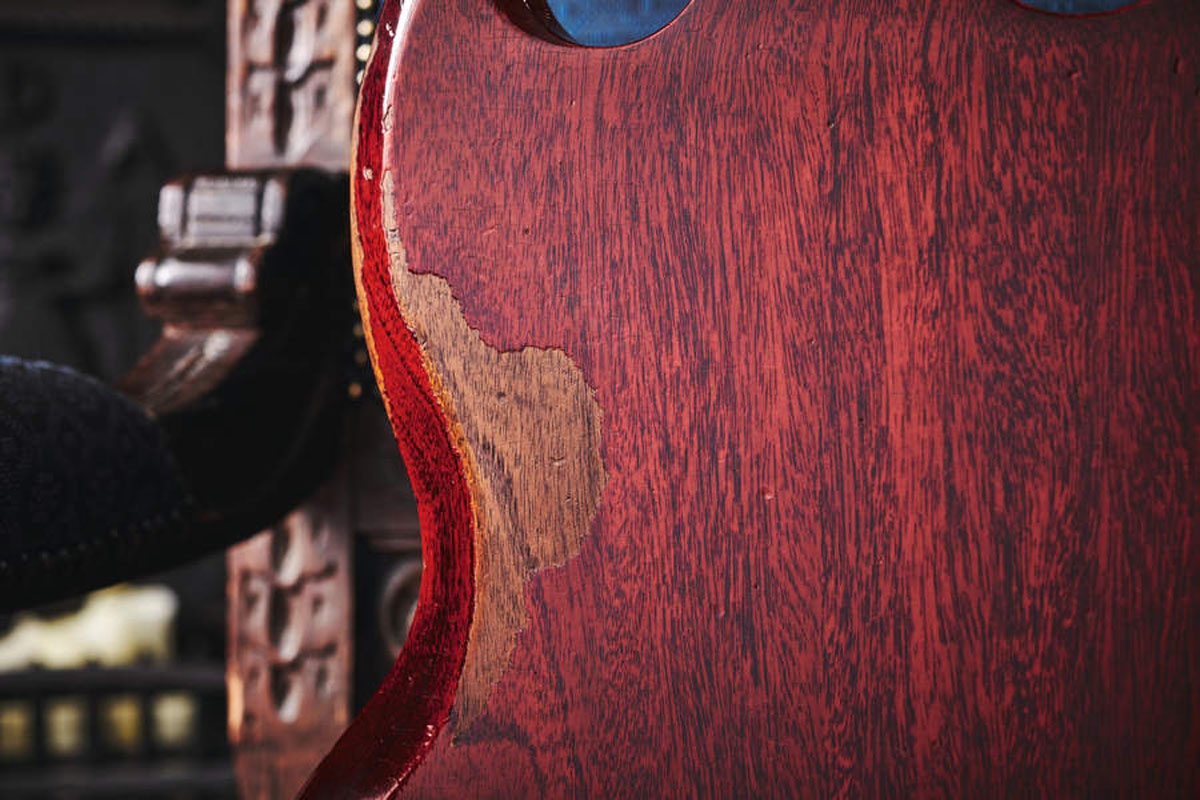
“It’s so perfect [when compared] to the original,” says Tony. “You could put them both in front of me and I couldn’t tell the difference”
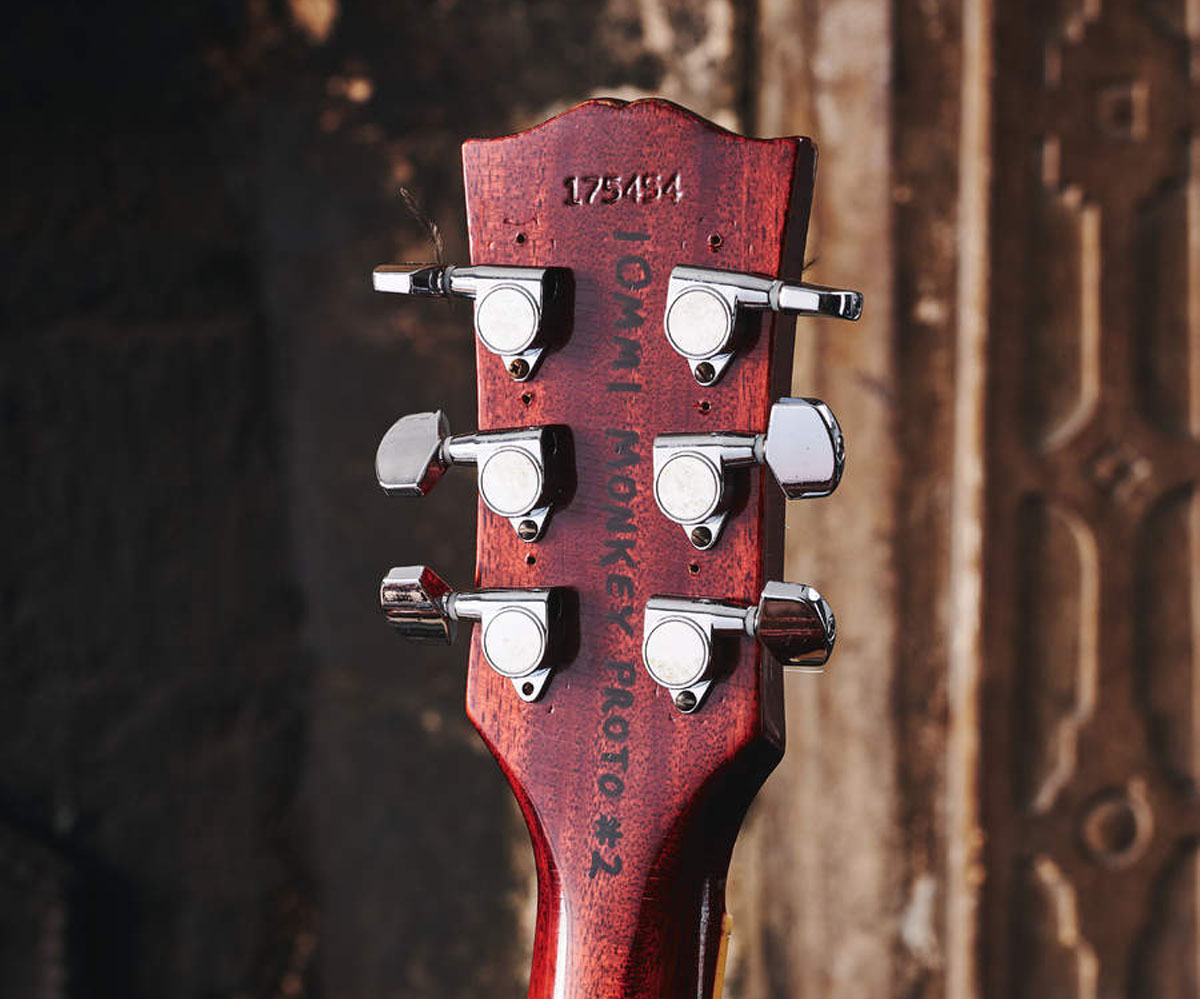
“I had Schaller tuners put on; you’d turn the old plastic keys and nothing would happen, after years of use”
When metal happened, which you and your SG were fundamental to, was it a natural evolution from, say, Cream and Led Zeppelin, or was it the chemistry between the four of you?
“Yes, absolutely [the chemistry]. I’d played in a band with Bill Ward before. We’d joined this blues band up in Carlisle. Then when Bill and myself got together with Oz and Geez, it was a weird combination. Geez had played guitar before but never bass. Bill and I used to play in this place in Birmingham. They’d do an all-nighter with four or five bands. Geez was in this other band, and he’d be doing acid and climbing up walls. You’d go, ‘Blimey, he’s nutty that guy.’ We never knew for a minute we’d end up playing with him. With Ozzy, I went to school with Ozzy and I never knew he was a singer.
"When we first got together we’d just learn 12-bar songs, and on the first gig we did, I didn’t even know what they were going to wear. Geezer came in in this long hippie dress. I’ve got my leather jacket on. Ozzy came with a shirt and a tap round his neck. I thought, ‘Bloody hell!’ We were a right odd bunch. But it brought us together and it just worked.”
For a while we couldn’t get anybody to talk to us, because they thought we were going to turn them into a fish or something
Was there a decision to go that dark route? Was it that you wanted to be scary?
“Well, I was always interested, and so was Geezer, in horror movies and stuff like that. So we had this interest in the supernatural. We said, ‘Imagine how people get frightened, get that excitement from a horror movie, that fear. It would be nice to do that in music.’
"And that’s how it took hold. Trying to make something in music that would give it the light and shade. Something a bit frightening. Which Black Sabbath, according to a lot of people, was. For a while we couldn’t get anybody to talk to us, because they thought we were going to turn them into a fish or something. The reputation built up and up and up.”
Of course, the guitar builder John Birch was also Birmingham based, and he was important in customising your SG and getting it sounding and playing how you wanted, and needed, due to your injury…
“Well, like I did with my Strat, I always used to have the SG in pieces. Do this to it, do that to it. Try and stop anything from feeding back, put tinfoil inside to shield all the bits, then dip the pickups and work on the frets, because they were too high for me. So I was constantly trying to improve it.
"Then the Badass bridge came out so you could adjust the intonation, which you couldn’t on the original Gibson SG Special bridge. That made a world of difference to me because I used such light gauge strings.
“Somebody recommended John Birch. I had these ideas that I wanted to try, because I’d approached some guitar companies and nobody was interested. I wanted a 24 fret guitar and I was told, ‘We can’t do it.’ So then when I said to John, ‘Can you build me a 24-fret guitar?’ he said, ‘Yes, let’s have a go.’
"Then we began experimenting with pickups. I’d try them on the gigs – he had to make them by hand, so I’d go out and come back, ‘No, it’s not right.’ And he’d do another one and another one until we got one that we felt comfortable with. Then I used the John Birch neck pickup on the SG, and I got John to encase the other one in epoxy, the P-90, in one of his covers, to try and stop the feedback – it was always a constant battle because we played loud.”
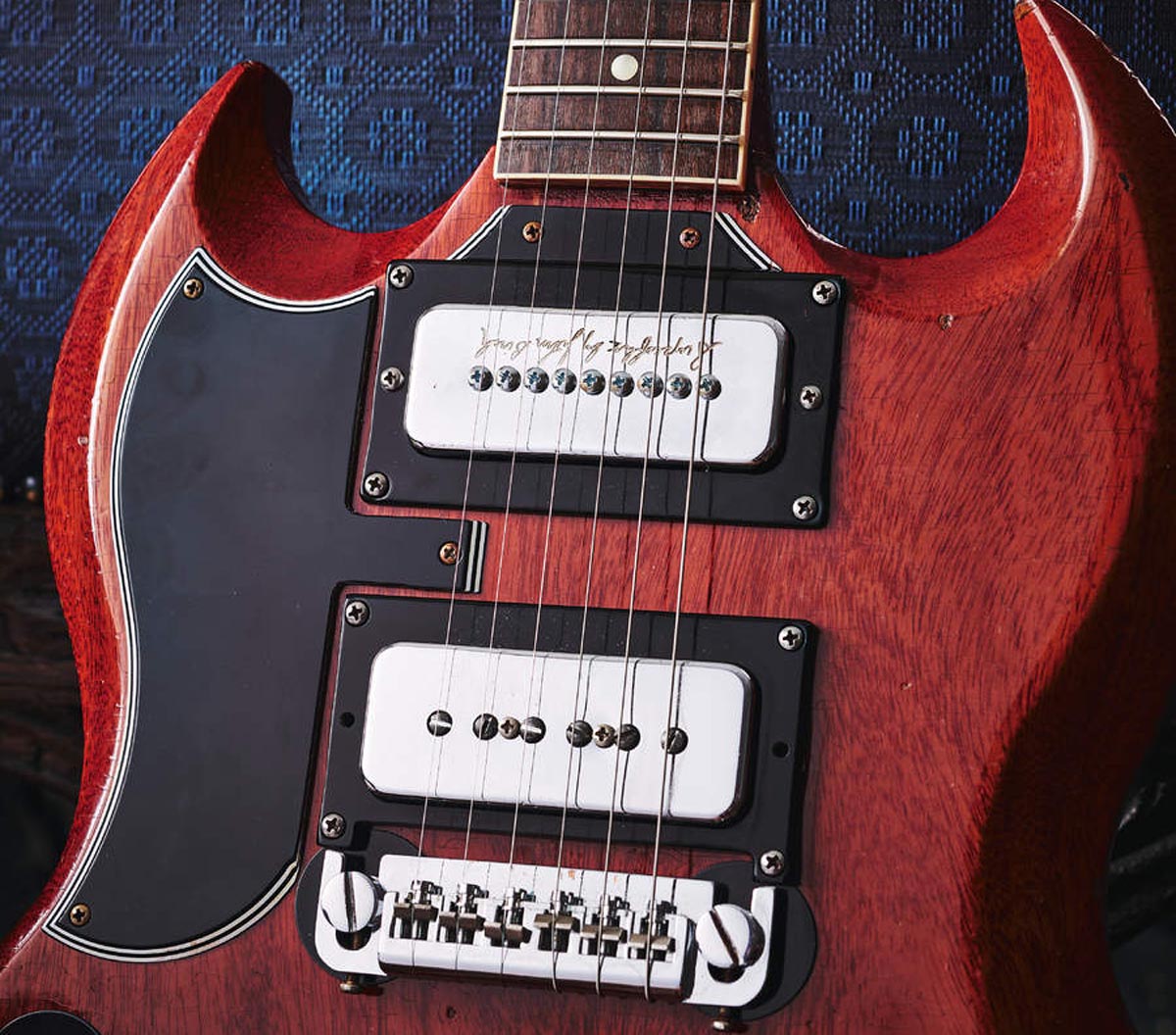
So you shaved the frets down and then had the fretboard lacquered as well?
“Yes, John Birch did that as well. I tried everything I could to make it easier for me, because of my fingers. Having high frets was disastrous because I’ve got thimbles on: they’re hard, not like the skin where you just glide over. So I had the lacquer put on to build up the fretboard so I could sort of roll over the frets.
"All these things were experiments to make things work for me. Like the first fret. Because I was using light strings, everything had to be worked differently. It had to be right from the off, because I was already struggling.”
So the fact that you had to do all these modifications because of the injury to your fingers, created a sound that might otherwise never have happened…
“I think so. And I experimented all the time. I’d always hear, ‘You can’t do that.’ Constantly. ‘Oh no, you can’t do that. 24-fret guitar, you can’t do that. It wouldn’t be harmonically right.’ ‘I’m using light-gauge strings.’ ‘You can’t do that.’ I can, I’ve done it. I’ve made my own set up, out of banjo strings first and dropped the gauge down. I eventually got Picato to make them, and then all the other companies caught on.
“But I constantly had to struggle with people saying, ‘You can’t do that.’ So I would find people to do it. It’s like with the amp. I had this treble booster – a Rangemaster – and I wanted it modified. This guy I met when I lived up in Carlisle with Bill Ward, this guitarist from a band that became Spooky Tooth, said, ‘I can make that sound better. I’ll take it and bring it back tomorrow.’
"He could have really cocked it up, but he took it away, put different components in it, brought it back and I loved it. It had got a great sound with the amps I was using at that time, which were Marshall 50s. He’d given it sustain and everything. So I went to a company saying, ‘Could you build this booster into the amp?’ ‘We can’t do that.’
I used to work on a way to make the sound bigger and get as much out of the guitar as I could
“But I’ve always had determination. I have to try and make something work and go against all these people who say, ‘You can’t do it.’ The same with my accident: they said, ‘You won’t be able to play any more.’ And I just wouldn’t accept that. I thought, ‘There’s got to be a way.’ It just made me try and figure out a way I could play. And the same with the music. ‘You can’t be playing that sort of stuff, it’s never going to sell and never going to do any good,’ but it’s a belief that you have to carry on.
“Before the accident, I could play regular chords like everybody else. But after the accident I had to think of different ways to approach the thing, because I couldn’t play a full chord the way they could. I used to work on a way to make the sound bigger and get as much out of the guitar as I could, hence all the fiddling about and making the thimbles.
"It was really a struggle. You had to be dedicated. I’m listening to all these people going, ‘You’re never going to be able to do that.’ So it was an upwards struggle from day one. Even my parents: ‘You’re not going to be able to play. Get a proper job.’”
You’ve told how your struggles to get the guitar right included John Birch building and modifying pickups. There’s a Birch one on the new SG, too. It’s obviously not made by him as John passed away years ago…
“Gibson got in touch with the people who worked with John. John had another guy working with him called John Diggins, who came on the road with me. JD got to know what sort of thing I’d like and what I’d use, and, of course, later on he started his company, Jaydee. But JD has sort of pulled back a bit now.
"His sons have worked for him for quite a while, so they build guitars as well. So it was somebody, I assume, there that they contacted. But the idea with this guitar was to reproduce everything about it, and they really have reproduced it exactly – every little bump and knock. When I saw it I said, ‘Bloody hell!’ It’s scary.”
Where’s the original?
“That’s in the Hard Rock Cafe now. It’s been in New York for a while, but they pulled it out of there to do this guitar. I’d stopped touring with it, because it was too fragile. I was worried about anything happening to it or it getting stolen. It used to travel with me all the time, but as you get more successful, it goes with the crew. So then it was out of my hands and I was a bit worried about that. I thought, ‘I’m going to stop touring with it.’
“So I kept the SG at home. Then it went into storage and I thought, ‘It’s a shame, really.’ Then the Hard Rock got in touch about selling it. The deal was they could have it, they’d pay me for it, and if I ever wanted it back, pay them the money back. The guy is dead now who I’d done the deal with, but I thought it would be better for people to be able to see it than me having it in a case with all the others.”
We hired Clearwell Castle in Wales and we set the gear up in the dungeons to give us some inspiration. The first thing I came up with was Sabbath Bloody Sabbath
And you tuned the SG down to Eb with very light strings, again to help with your struggle to play, let alone to come up with some of the greatest rock riffs of all time!
“I had different gauges on stage for different songs. Because one album we did, Master Of Reality, we tuned down three semitones. So if we do any songs off that album, I need a guitar with a thicker string. But generally on stage, from the early days it was eights. It was .008, .011, .016, down to .032. Actually, the first album was in regular tuning, but then we tuned down on stage, both for Ozzy and for me with my fingers.
“But, yes, they relied on me to come up with the riffs. Geezer came up with some as well, but it was mainly me. Hence if I didn’t come up with anything we’d be stumped – and that did happen later when we went to do what turned out to be Sabbath Bloody Sabbath. We’d had a great time doing Vol 4 in the Record Plant [in Los Angeles], so we went back to America, to the same house and everything. But Stevie Wonder had built a bloody Moog in the studio so [the space] was too small.
"That was the first disaster. The next one was I couldn’t come up with any ideas; it was just horrible. So we came back to England and we had a few weeks off. Then we hired Clearwell Castle in Wales and we set the gear up in the dungeons to give us some inspiration. The first thing I came up with was Sabbath Bloody Sabbath. The first riff I did! I thought, ‘That’s it, we’re off.’ So that led the way and we were going again.
“Usually, the riffs would come first. Ozzy would sing anything on it, then that would go to Geezer who would do the lyrical side. So Geezer was generally the one who came up with the lyrics, and Ozzy would do the melody lines. We’d use some of the words from the original thing he’d just made up, so it was a combination of everybody, really.
“But we weren’t bothered about money. We really weren’t, because we didn’t have anything anyway. We just wanted to play. Our highlight when we first started was to get out of Birmingham and play in London. And, of course, when we did that they hated us. It was a bit of a disaster, really.
“We played at the Speakeasy, and we’d just started out. It was Alvin Lee, actually, who got us that gig. I used to go round to his house and I brought the lads round a couple of times. We’d sit there talking about what we were going to do. We said to him one day, ‘We’re going to change the name,’ because we were called Earth, and we said, ‘We’re going to change it to Black Sabbath.’ ‘Oh, that will never do any good.’ We plagued him for years about that.”
You’re known as the Dark Lord Of Riffs, but you could have played in many different bands, because your playing is broad enough and you’re musical enough…
“Thanks. It’s hard for me to see. I tend to set myself in that vein with what we do. I’ve always been a bit, not scared, to jump out of my field. I do on my own, but if you shoved me in the Eagles I’d go, ‘Oh Christ, what do I do here?’ Much like when I was with Jethro Tull. I did that short thing with them, after Mick Abrahams and before Martin Barre.
“We’d supported them on one of their gigs, and they asked me and I was like, ‘Oh God, I don’t know.’ On the way back, I was driving the van and I said, ‘They’ve asked me if I’ll join them.’ And they’re going, ‘You should go for it, it’s a great opportunity.’ I felt really bad. When I had a call from their office to come down and play, I went to London. I got there and there’s like 50 guitar players. I went, ‘Oh God, what’s going on?’ because I thought it was just me.
"I got really nervous and walked out and a guy came running after me. He said, ‘Don’t go, don’t go.’ I said, ‘I can’t do it, there’s all these other guitar players.’ He said, ‘Sit in the cafe and when they’re all gone I’ll come and get you.’ So that’s what we did. And then they offered me the job.
“It was good and bad, because I felt really sad for the others. When I went down to play with them I took Geezer with me. I kept saying to him, ‘I don’t feel comfortable about it.’ When I told them, ‘It’s not for me,’ they said, ‘We’ve got this movie [The Rolling Stones Rock And Roll Circus] and we can’t get anybody else quickly enough. Could you do it?’ I said, ‘Yes, I’d do that.’ Then I started doing that and meeting John Lennon and everybody, and I thought to myself, ‘Have I done the right thing, going back to playing at this blues club up the road?’ But that’s how it happened.”
What about your influences? Given the era in which you grew up, where there was so much new music happening, presumably Hank Marvin was high on the list as you’re a melodic player yourself?
“Absolutely. Me and Brian May both loved Hank. We’re not widdly diddlies. Brian and I have done a few things, played together on albums. We were in the studio together once and we started playing Shadows stuff. So it was mainly Hank, then Chuck Berry and a bit of Buddy Holly. I liked Clapton. I liked John Mayall. That line-up was really appealing. When he went with Cream I wasn’t so enthusiastic, but then I got used to Cream. I loved his style and his sound.
“But, yes, you had bands like The Moody Blues, Fleetwood Mac, John Mayall, Cream. Then you had Deep Purple, Led Zeppelin, and us. We knew Planty and Bonham. Bonham was best man at my first wedding. I used to knock about with him a lot. We used to play the same gigs. We’d be playing at this club and he’d be with another band. ‘They fired me.’ ‘What happened?’ ‘I’m too loud.’ And then he’d go with another band and get fired from them because he was too loud. He was constantly in and out of bands.”
Brian May came over and I gave him four or five CDs of riffs, and he’s going, ‘You’ve got to do an album with these, just put them out like that.’ I said, ‘No, I don’t want to do that. I’m going to do them properly
Did anybody else turn you on later? People like Yngwie Malmsteen or Van Halen?
“Van Halen, yes. We took Van Halen on their first big tour. They were with us for eight months. Eddie was playing things I’d never seen before. We’re still friends and we became friends then. Of course, he set off a whole new load of players playing like that, and now I can’t believe some of them. I can’t follow it. I certainly couldn’t do it.”
So, any plans to make new music with your new SG? More solo stuff? Collaborations?
“Well, that’s the million-dollar question. I’ve got loads of stuff. I keep saying to Ralph [Baker], my manager, ‘I want to put it down properly,’ but the engineer I’ve used for years, Mike Exeter, has gone on to do other things… I’d like to put some stuff down, but it won’t be a touring band. Actually, Brian May came over and I gave him four or five CDs of riffs, and he’s going, ‘You’ve got to do an album with these, just put them out like that.’ I said, ‘No, I don’t want to do that. I’m going to do them properly.’”
It would be great to get people you really admired to participate. They’d jump at it!
“Yes, I’d like that. I sort of did it with the Iommi album in 2000. I had Dave Grohl, Billy Corgan and all sorts of people on it. Another two embarrassing things that I didn’t go for was one where they said, ‘This chap wants to do something. Eminem.’ ‘Who the bloody hell is Eminem?’ I didn’t know, and I went, ‘Oh, no.’ And Kid Rock.
"So I turned a few people down that became quite big later, but I hadn’t the faintest idea. I’d tried to do it before with Planty and a few others, but it was so hard because of management and all that. But the last one, they really wanted to do it, and I enjoyed playing with different people.”
When you were struggling to play again, possibly wondering if you ever really would, could you have imagined that a company would build you a guitar, let alone Gibson?
“No, never – when I think back, how difficult it was. Now you could say, ‘Send me a couple of guitars,’ whichever company it is, and they’d do it. But I believe in having guitars I like; I don’t just want loads of guitars. There’s always been companies saying, ‘Can we give you a couple of guitars?’ ‘But I’m using these – I like these.’ Not to be funny, I knew people years ago who would have anything they could and then sell it!
“But getting back to this guitar, they said they’d do it and straight away they did it. And it’s exactly the same. Exactly the same. It was my guitar and I can’t bloody tell. I’ve got it at home in my bedroom. I regard that as my original now!”
In the late '70s and early '80s Neville worked for Selmer/Norlin as one of Gibson's UK guitar repairers, before joining CBS/Fender in the same role. He then moved to the fledgling Guitarist magazine as staff writer, rising to editor in 1986. He remained editor for 14 years before launching and editing Guitar Techniques magazine. Although now semi-retired he still works for both magazines. Neville has been a member of Marty Wilde's 'Wildcats' since 1983, and recorded his own album, The Blues Headlines, in 2019.

